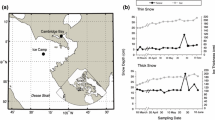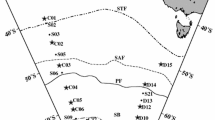Abstract
The phytoplankton and sea ice algal communities at the end of winter in McMurdo Sound were dominated by Fragilariopsis sublineata, with Thalassiosira antarctica, Melosira adele, Pinnularia quadreata, Entomoneis kjellmannii and heterotrophic dinoflagellates also present. Sea ice algal biomass at the end of winter was very low, only 0.050 ± 0.019 mg chla m−2 in 2007 and 0.234 ± 0.036 mg chla m−2 in 2008, but this increased to 0.377 ± 0.078 mg chla m−2 by early October in 2007 and to 1.07 ± 0.192 by late September in 2008. Under ice phytoplankton biomass remained consistently below 0.1 μg chla l−1 throughout the measuring period in both years. The photosynthetic parameters Fv/Fm, rETRmax and α document microalgal communities that are mostly healthy and well adapted to their low light under ice environment. Our results also suggest that species such as Fragilariopsis sublineata are well adapted to deal with low winter light levels but are unlikely to survive an increase in irradiance, whereas other taxa, such as Thalassiosira antarctica, will do better in a higher light environment.


Similar content being viewed by others
References
Archer SD, Leakey RCG, Burkill PH, Sleigh MA, Appleby CJ (1996) Microbial ecology of sea ice at a coastal Antarctic site: community composition, biomass and temporal change. Mar Ecol Prog Ser 135:179–195
Arrigo KR, Sullivan CW (1992) The influence of salinity and temperature covariation on the photophysiological characteristics of Antarctic sea ice microalgae. J Phycol 28:746–756
Bunt JS, Lee CC (1972a) Date on the composition and dark survival of four sea ice microalgae. Limnol Oceanog 17:458–461
Bunt JS, Lee CC (1972b) Seasonal primary production in Antarctic sea ice at McMurdo Sound in 1967. J Mar Res 28:304–305
Dieckmann GS, Lange MA, Ackley SF, Jennings JC (1991) The nutrient status in sea ice of the Weddell Sea during winter: effects of sea ice texture and algae. Polar Biol 11:449–456
Fiala M, Kuosa H, Kopczynska EE, Oriol L, Delille D (2006) Spatial and seasonal heterogeneity of sea ice microbial communities of first-year ice in the Terra Adelie area (Antarctica). Aquatic Microb Ecol 43:95–106
Genty B, Briantais JM, Baker NR (1989) The relationship between the quantum yield of photosynthetic electron transport and quenching of chlorophyll fluorescence. Biochim Biophys Acta 990:87–92
Griffith GP, Vennell R, Lamare MD (2009) Diadinoxanthin cycle of the bottom ice algal community during spring in McMurdo Sound, Antarctica. Polar Biol 32:623–636
Grossi SM, Kottmeier ST, Sullivan CW (1984) Sea ice microbial communities. 3. Seasonal abundance of microalgae and associated bacteria, McMurdo-Sound, Antarctica. Mar Ecol 10:231–242
Gunter S, Dieckmann GS (1999) Seasonal development of algal biomass in snow-covered fast ice and the underlying platelet layer in the Weddell Sea, Antarctica. Antarctic Sci 11:305–315
Holm-Hansen O, Riemann B (1978) Chlorophyll a determination: improvements in methodology. Oikos 30:438–447
Holm-Hansen O, Amos AF, Hewes CD (2000) Reliability of estimating chlorophyll a concentrations in Antarctic waters by measurement of in situ chlorophyll a fluorescence. Mar Ecol Prog Ser 196:103–110
Jasby AD, Platt T (1976) Mathematical formulation of the relationship between photosynthesis and light for phytoplankton. Limnol Oceanog 21:540–547
Kirst GO, Wiencke C (1995) Ecophysiology of polar algae. J Phycol 31:181–199
Knox GA (2006) Biology of the Southern Ocean, 2nd edn. CRC Press, Boca Ratan
Kottmeier ST, Sullivan CW (1988) Sea ice microbial communities (SIMCO). IX. Effects of temperature and salinity on rates of metabolism and growth of autotrophs and heterotrophs. Polar Biol 5:293–304
Lewis J, Harris ASD, Jones KJJ, Edwards RLE (1999) Long-term survival of marine planktonic diatoms and dinoflagellates in stored sediment samples. J Plank Res 21:343–354
Lizotte MP, Sullivan CW (1992a) Biochemical-composition and photosynthate distribution in sea ice microalgae of McMurdo-Sound, Antarctica—evidence for nutrient stress during the spring bloom. Antarctic Sci 4:23–30
Lizotte MP, Sullivan CW (1992b) Rates of photoadaptation in sea ice diatoms from McMurdo Sound, Antarctica. J Phycol 27:367–373
Luder UH, Wiencke C, Knoetzel J (2002) Acclimation of photosynthesis and pigments during and after 6 months of darkness in Palmaria decipens (Rhodophyta): a study to simulate Antarctic winter sea ice cover. J Phycol 38:904–913
McMinn A, Ashworth C (1998) The use of oxygen microelectrodes to determine the net production by an Antarctic sea ice algal community. Antarctic Sci 10:30–35
McMinn A, Hegseth EN (2004) Quantum yield and photosynthetic parameters of marine microalgae from the southern Arctic Ocean, Svalbard. J Mar Biol Assoc UK 85:865–871
McMinn A, Ashworth C, Ryan K (1999) Growth and productivity of Antarctic sea ice algae under PAR and UV irradiances. Botanica Marina 42:401–407
McMinn A, Ashworth C, Ryan K (2000) In situ net primary productivity of an Antarctic fast ice bottom algal community. Aquatic Microb Ecol 21:177–185
McMinn A, Ryan K, Gademann R (2003) Photoacclimation of Antarctic fast ice algal communities determined by pulse amplitude modulation (PAM) fluorometry. Mar Biol 143:359–367
McMinn A, Harawake T, Hamoke H, Hattori H, Fukuchi M (2005a) Contribution of benthic microalgae to ice covered coastal ecosystems in northern Hokkaido, Japan. J Mar Biol Assoc UK 85:283–289
McMinn A, Pankowski A, Delfatti T (2005b) Effect of hyperoxia on the growth and photosynthesis of polar sea ice algae. J Phycol 41:732–741
McMinn A, Ryan KR, Ralph PJ, Pankowski A (2007) Spring sea ice photosynthesis, primary productivity and biomass distribution in eastern Antarctica, 2002–2004. Mar Biol 151:985–995
Medlin LK, Priddle J (1990) Polar marine diatoms, British Antarctic Survey, Natural Environment Research Council, Cambridge
Meiners KM, Papadimitriou S, Thomas DN, Norman L, Dieckmann GS (2009) Biogeochemical conditions and ice algal photosynthetic parameters in Weddell Sea ice during early spring. Polar Biol 32:105–1065
Nelson DM, Smith WO (1991) Sverdrup revisited—critical depths, maximum chlorophyll levels, and the control of southern-ocean productivity by the irradiance-mixing regime. Limnol Oceanog 36:1650–1661
Nozue K, Maloof JN (2006) Diurnal regulation of plant growth. Plant Cell Environ 29:396–408
Palmisano AC, Sullivan CW (1982) Physiology of sea ice diatoms. I. Response of three polar diatoms to a simulated summer-winter transition. J Phycol 18:489–498
Palmisano AC, Sullivan CW (1983a) Physiology of sea ice diatoms. 2. Dark survival of three polar diatoms. Can J Microbiol 129:157–158
Palmisano AC, Sullivan CW (1983b) Sea ice microbial communities (SIMCO). 1. Distribution, abundance, and primary production of ice microalgae in McMurdo-Sound, Antarctica in 1980. Polar Biol 2:171–177
Palmisano AC, Soohoo JB, Sullivan CW (1985) Photosynthesis-irradiance relationships in sea ice microalgae from McMurdo Sound, Antarctica. J Phycol 21:341–346
Palmisano AC, Beeler Soohoo J, Sullivan CW (1987) Effects of four environmental variables on photosynthesis-irradiance relationships in Antarctic sea-ice microalgae. Mar Biol 94:299–306
Pankowski A, McMinn A (2009) Development of immunoassays for the iron- regulated proteins Ferredoxin and flavodoxin in polar microalgae. J Phycol 45:771–783
Peters E, Thomas DN (1996) Prolonged darkness and diatom mortality. 1: Marine Antarctic species. J Experim Mar Biol Ecol 207:25–41
Ralph PJ, Gademann R (2005) Rapid Light curves: a powerful tool to assess photosynthetic activity. Aquatic Bot 82:222–237
Ralph PJ, McMinn A, Ryan KG, Ashworth C (2005) Effect of salinity and temperature on the photokinetics of brine channel algae. J Phycol 41:763–769
Rivkin R (1991) Seasonal patterns of planktonic production in McMurdo Sound, Antarctica. Amer Zool 31:5–16
Rivkin RB, Putt M, Alexander SP, Meritt D, Gaudet L (1989) Biomass and production in polar planktonic and sea ice microbial communities: a comparative study. Mar Biol 101:273–283
Robinson DH, Arrigo KR, Iturriaga R, Sullivan CW (1995) Microalgal light-harvesting in extreme low-light environments in McMurdo Sound, Antarctica. J Phycol 31:508–520
Robinson DH, Kolber Z, Sullivan CW (1997) Photophysiology and photoacclimation in surface sea ice algae from McMurdo Sound, Antarctica. Mar Ecol Prog Ser 147:243–256
Robinson DH, Arrigo KR, Kolber Z, Gosselin M, Sullivan CW (1998) Photophysiological evidence of nutrient limitation of platelet ice algae in McMurdo Sound, Antarctica. J Phycol 34:788–797
Ryan KG (1992) UV-radiation and photosynthetic production in Antarctic sea ice microalgae. J Photochem Photobiol B-Biol 13:235–240
Ryan KG, Hegseth EN, Martin A, Davy SK, O’Toole R, Ralph PJ, McMinn A, Thorn CJ (2006) Comparison of the microalgal community within fast ice at two sites along the Ross Sea coast, Antarctica. Antarctic Sci 18:583–594
Ryan KG, Cowie REM, Liggins E, McNaughtan D, Martin A, Davey SK (2009) The short-term effect of irradiance on the photosynthetic properties of Antarctic fast-ice microalgal communities. J Phycol 45:1290–1298
Schandelmeier L, Alexander V (1981) An analysis of the influence of ice on spring phytoplankton population structure in the Southeast Bering Sea. Limnol Oceanogr 26:935–943
Schreiber U (2004) Pulse-amplitude (PAM) fluorometry and saturation pulse method. In: Papageorgiou GC, Govindgee (eds) Chlorophyll fluorescence: a signature of photosynthesis. Advances in photosynthesis and respiration series. Kluwer Academic Publishers, Dordrecht
Scott FJ, Marchant HJ (2005) Antarctic marine protists. Australian Biological Resources Study, Canberra and Australian Antarctic Division, Hobart
Smith WO, Nelson DM (1986) The importance of ice-edge phytoplankton productivity in the Southern Ocean. Bioscience 36:251–257
Smith WO, Nelson DM, Ditullio GR, Leventer AR (1996) Temporal and spatial patterns in the Ross Sea: phytoplankton biomass, elemental composition, productivity and growth rates. J Geophys Res Oceans 101:18455–18465
Swadling KM, McPhee A, McMinn A (2000) Spatial distribution of copepods in fast ice of eastern Antarctica. Polar Biosci 13:55–65
Thomas DN, Dieckman GS (2010) Sea ice, 2nd edn. Wiley-Blackwell Science, Chichester
Tilzer MM, Dubinsky Z (1987) Effects of temperature and day length on the mass balance of Antarctic phytoplankton. Polar Biol 7:35–42
Trenerry LJ, McMinn A, Ryan KG (2002) In situ oxygen microelectrode measurements of bottom-ice algal production in McMurdo Sound, Antarctica. Polar Biol 25:72–80
Acknowledgments
We would like to thank the staff of Antarctica New Zealand for providing logistics and field assistance while at Scott Base. Andrew McMinn received financial assistance from the Australian Research Council and Ken Ryan received support from FRST.
Author information
Authors and Affiliations
Corresponding author
Rights and permissions
About this article
Cite this article
McMinn, A., Martin, A. & Ryan, K. Phytoplankton and sea ice algal biomass and physiology during the transition between winter and spring (McMurdo Sound, Antarctica). Polar Biol 33, 1547–1556 (2010). https://doi.org/10.1007/s00300-010-0844-6
Received:
Revised:
Accepted:
Published:
Issue Date:
DOI: https://doi.org/10.1007/s00300-010-0844-6




